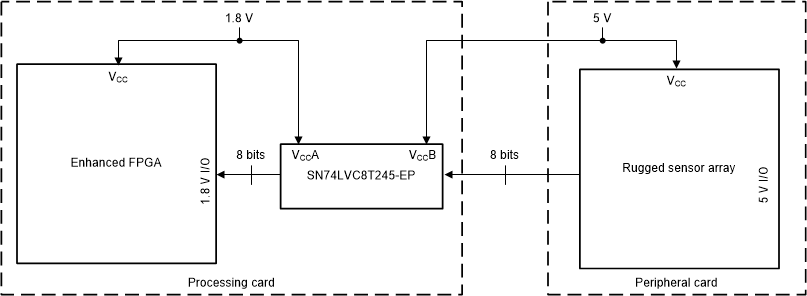SCEA111 July 2021 SN74AVCH4T245-EP , SN74LVC16T245-EP , SN74LVC1T45-EP , SN74LVC2T45-EP , SN74LVC8T245-EP
1 Application Brief
As applications such as commercial aircraft, drones, and countless military systems evolve into more software-defined applications, system designers are leveraging enhanced FPGAs to help implement these new smarter systems. Enhanced-grade FPGAs have become more prevalent as the industry need has increased for more capable ruggedized applications. New enhanced FPGAs take advantage of the underlying innovations that have occurred in the commercial FPGA arena over the past decade. FPGA designs have migrated down the CMOS process curve to smaller deep sub-micron process geometries allowing for new capabilities and features. New enhanced FPGAs enable higher Look Up Table (LUT) counts, enhanced feature sets, faster processing, and a richer set of inputs and outputs (I/O). Rugged high-reliability applications have been able to utilize new FPGAs to increase system capabilities, shrink form factors, extend mission duration, and enable new usage models.
One design challenge that high-reliability system designers face when using enhanced FPGAs is interfacing to the wide assortment of peripheral devices that connect to the FPGA. The deep sub-micron nature of new enhanced FPGAs has driven core and I/O voltages lower than common voltage levels. It is now common for system designers to encounter I/O voltage level mismatches between the FPGA I/O and connecting peripheral device I/O. In addition, it is often advantageous for designers to operate larger FPGAs at lower core voltages to achieve power savings as well as better thermal performance.
To help resolve I/O level mismatches between enhanced FPGAs and peripheral devices like sensors, for high reliability applications, system designers can leverage a growing list of enhanced level-shifting solutions. For example, system engineers can leverage level-shifting solutions such as TI’s enhanced plastic (EP) LVC level translation devices. TI's EP LVC translators enable level shifting between I/O that operate from 5.5 V to 1.65 V encompassing popular voltage rails such as 1.8 V, 2.5 V, and 3.3 V. Similar to other enhanced plastic products, the enhanced LVC translation devices offer a higher level of quality and reliability than commercial off-the-shelf devices. Enhanced products provide benefits such as single controlled baseline flow, extended temperature ranges from –55°C to 125°C, accelerated stress testing, and other benefits often required for avionics and defense use cases. The example in Figure 1-1 shows the implementation of the SN74LVC8T245-EP 8-bit level translator level shifting between a lower voltage FPGA and a higher voltage sensor array.
Similar use cases can be implemented for high-reliability applications using enhanced level translation solutions covering I/Os that span from 1- to 16-bit interfaces with a single device. In addition, a combination of different bit width translation devices, as shown in Table 1-1, can also be used. System engineers developing high reliability applications can get the most out of their enhanced FPGA implementations by using enhanced level translation solutions from Texas Instruments.
For more information on TI’s level translation solutions, please visit the level translation landing page at www.ti.com/translation.
 Figure 1-1 Example of Level Translation With an Enhanced FPGA
Figure 1-1 Example of Level Translation With an Enhanced FPGAKey Benefits of Direction-Controlled Translation
- Buffered outputs for higher drive strength
- Channel bit widths up to 16 bits
- One or more direction control pins
- Support for higher data rates
- Can be used for translation of common control interfaces such as SPI, UART, JTAG, GPIO and I2S
| Part Number | Bits | Package | Pin Count | Data Rate (MAX- Mbps) | VOUT (Max V) | VOUT (Min V) |
|---|---|---|---|---|---|
| SN74AVCB164245-EP | 16 | TSSOP|48, TSSOP|48 | 200 | 3.6 | 1.4 |
| SN74LVC16T245-EP | 16 | TSSOP|48, TSSOP|48 | 200 | 5.5 | 1.65 |
| SN74AVCH4T245-EP | 4 | UQFN|16 | 380 | 3.6 | 1.2 |
| SN74LVC8T245-EP | 8 | SOIC|24, TSSOP|24, VQFN|24 | 200 | 5.5 | 1.65 |
| SN74LVCH16T245-EP | 16 | TSSOP|48|TVSOP|48 | 200 | 5.5 | 1.65 |
| SN74LVC1T45-EP | 1 | SC70|6 | 300 | 5.5 | 1.65 |
| SN74LVC2T45-EP | 2 | SM8|8 | 420 | 5.5 | 1.65 |
| CD4504B-EP | 6 | TSSOP|16 | 24 | 18 | 5 |
| SN74LVCC4245A-EP | 8 | TSSOP|24 | 200 | 5.5 | 2.7 |
| SN74ALVC164245-EP | 16 | SSOP|48 TSSOP|48|TSSOP|48 | 300 | 5.5 | 2.3 |
| SN74LVCC3245A-EP | 8 | SOIC|24, SSOP|24, TSSOP|24 | 200 | 5.5 | 2.3 |
| SN74LVC4245A-EP | 8 | TSSOP|24 | 200 | 5.5 | 2.7 |